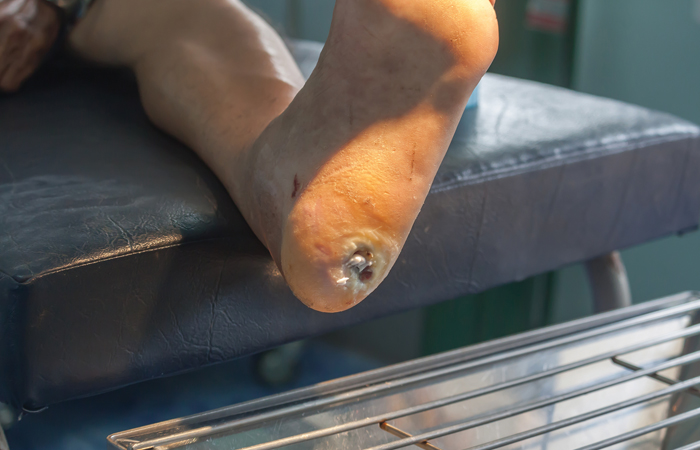In Conditions
Follow this topic
Bookmark
Record learning outcomes
More than 5.8 million people in the UK are living with diabetes, according to charity Diabetes UK, which estimates that there are an additional 1.3 million who have type 2 diabetes but are, as yet, undiagnosed.
Worryingly, new research from Tesco Pharmacy reveals that public awareness of the condition is surprisingly low. Nearly one in five people surveyed could not identify a risk factor for type 2 diabetes (19 per cent) or a single sign or symptom of developing any type of diabetes (20 per cent).
What’s more, 26 per cent of respondents also said they would rather wait and see how health concerns developed before speaking to a healthcare professional.
So, what can pharmacy teams do to raise awareness of diabetes, and help customers at risk?
What is diabetes?
Diabetes is a serious condition where the body’s blood glucose level is too high, either because it doesn’t produce enough insulin, or the insulin it produces isn’t effective. Insulin is a hormone made by the pancreas that allows glucose in the blood to enter cells and fuel our bodies, but for people with diabetes, this system doesn’t work.
There are two main types of diabetes: type 1 and type 2. In type 1, the body cannot make any insulin at all, as its insulin-producing cells have been attacked and destroyed by its own immune system.
This is why type 1 diabetes is known as an autoimmune condition. In type 2 diabetes the body isn’t making enough insulin or what it makes isn’t working properly. This can be for many reasons, but type 2 diabetes isn’t an autoimmune condition.
According to Diabetes UK, type 1 diabetes affects eight per cent of people living with diabetes and type 2 diabetes affects 90 per cent of people living with diabetes.
As yet, there is no known cause for type 1 diabetes, although family history can slightly increase the risk, as there are a number of genes linked to type 1 diabetes.
Age, family history, ethnicity, waist circumference and living with obesity or overweight are all risk factors for type 2 diabetes.
Diagnosis, management and care
Although it’s often diagnosed in childhood, people can develop type 1 diabetes at any age, but are more likely to be diagnosed if they are under 40.
Type 1 diabetes is treated by taking insulin, with Diabetes UK advising that people count the carbohydrates they eat and drink, and try to balance this with doses of insulin, as well as being as active as possible, eating healthily and going for regular health checks.
There is no permanent cure currently available for either type 1 or type 2 diabetes, but Diabetes UK is funding research into type 1 screening in light of a new treatment being developed which can delay the condition in those people found to be at risk.
Unlike type 1 diabetes, the risk of developing type 2 diabetes increases with age, and it doesn’t only affect people living with obesity or overweight – it is connected to ethnicity. People are more at risk if they are white and over 40, or over 25 if they are African-Caribbean, Black African, Chinese or South Asian.
Symptoms of type 2 diabetes can be easier to miss because they appear more slowly, meaning people can live with type 2 diabetes for several years without realising.
However, unlike type 1 diabetes, there are things people can do to reduce the risk of developing type 2 diabetes, such as eating healthily, being active and maintaining a healthy weight, and with the right support, about half of all cases of type 2 diabetes can be prevented or delayed, and in some cases put into remission.
Sometimes type 2 diabetes can be treated without taking insulin or other medication to help lower blood sugar levels.
According to Diabetes UK, the main treatments for managing blood sugar levels in type 2 diabetes are eating well and moving more, weight loss, the medicine metformin (usually taken as a tablet), and insulin along with other medication that helps lower blood sugar levels.

Diabetic customers are more vulnerable to complications if they get the flu, so encourage them to get vaccinated this flu season.
“Nearly one in five people surveyed could not identify a risk factor for type 2 diabetes”
The importance of good foot care
Having diabetes puts people at much greater risk of developing foot problems, since having raised blood glucose levels can damage the small blood vessels that supply the nerves in the feet. This can result in the loss of feeling in the feet known as peripheral neuropathy.
Damaged blood vessels also reduce the blood supply to the feet, resulting in problems with cuts and sores healing. If left untreated, these foot problems can lead to foot ulcers, infections and, at worst, amputations.
Symptoms of diabetes-related foot problems include:
- Tingling sensation or pins and needles like numbness
- Burning pain or dull ache
- Loss of feeling in feet or legs
- Swollen feet
- Cuts, wounds or sores that don’t heal
- Cramp in the calves when resting or walking
- Shiny, smooth skin on the feet
- Hair loss on legs and feet
- Toes that are bent into a claw shape
Everyone with diabetes should have an annual foot check free on the NHS which will involve a health professional looking at their feet, asking questions about any changes and checking the blood supply. They can refer the patient on to a podiatrist to develop a personalised care plan, alongside footcare and footwear advice.
Alongside attending an annual foot check, people living with diabetes can prevent foot problems by:
- Checking their feet daily
- Following a healthy diet and keeping active
- Getting help to give up smoking
- Keeping blood sugars as close to target as possible
- Managing blood fat levels and blood pressure to help protect blood vessels and nerves
- Speak to their healthcare team to check if they need to do anything else to help manage their diabetes.
Pharmacy teams can advise patients worried about their feet that if they notice something new that they are worried about to contact their GP or foot protection team straight away, or call 111 for advice.
Signs and symptoms in the pharmacy
Recognising the early signs of diabetes can be life-saving, and pharmacy teams are often well placed to notice the red flags before customers themselves realise something is wrong.
Pharmacist Satyan Kotecha, a Diabetes UK Clinical Champion who runs diabetes clinics in general practice in Leicester, explains: “Type 1 usually presents in hospital with sudden onset. The person will be feeling very unwell, with stomach cramps, sweating and breath that may smell like pear drops due to [the] production of ketones. As it’s so acute, it’s rarely picked up in community pharmacy.”
By contrast, symptoms of type 2 diabetes tend to develop more gradually. “For type 2, I suggest pharmacy teams look out for the 5Ts,” says Satyan.
“Thirst, toilet (frequency of passing urine), tiredness, thrush (frequent bouts of thrush or UTI), and getting thinner – so unexplained weight loss and craving of sugary foods.”
Jacquie Lee, Numark medication safety officer and information pharmacist, adds that there are several warning signs that may overlap in both type 1 and type 2 diabetes.
“Frequent urination, excessive thirst, unexplained weight loss (more common in type 1), extreme fatigue, blurred vision, slow healing of cuts and bruises, and tingling or numbness in hands or feet (more common in type 2),” are all symptoms to look out for.
“Patients may mention these symptoms casually when seeking remedies for fatigue, dry skin, or recurrent infections,” she says. “Pharmacy staff should be alert to patterns and consider signposting patients to their GP for further investigation, especially if multiple symptoms are present.”
Living with type 1 diabetes
Supporting people with type 1 diabetes goes well beyond dispensing insulin, and community pharmacy teams are in a unique position to provide practical guidance, encouragement and signposting to wider resources.
“Community pharmacy teams can provide vital support by educating patients on insulin types, dosing schedules, and storage,” says Jacquie.
“They should promote adherence to insulin regimens and blood glucose monitoring and offer advice on managing hypoglycaemia and recognising signs of diabetic ketoacidosis (DKA).”
“Pharmacy teams can also encourage the use of technology, such as continuous glucose monitors (CGMs), where appropriate, and signpost to support groups and online resources for emotional and peer support.”
Satyan agrees, emphasising the need for consistent education and engagement. “People living with type 1 diabetes often don’t engage with services as well, and the morbidity and mortality is higher than in type 2, as patients are usually younger and struggle to cope.
Key areas where pharmacy support makes a difference includes advising on hypo management, and signposting to structured education such as DAFNE (Dose Adjustment For Normal Eating), and practical resource tools from Diabetes UK.”
Living with type 2 diabetes
Pharmacy teams are similarly central to supporting people living with type 2 diabetes, from prevention and detection through to ongoing management.
Once someone is diagnosed, Satyan stresses the importance of ongoing vigilance, saying: “It’s vital to discuss side effects with medication and adherence, and to encourage patients to attend their annual review and retinopathy screening.
They should also check their feet regularly, attend the dentist, and ‘know their numbers’ in relation to their HbA1c, lipids and blood pressure, so they know what their treatment targets are and if they need a statin.”
Cost and time pressures, however, remain barriers for many. The Tesco survey found that the biggest blockers for 30 per cent of people was the cost of healthy food, and 22 per cent the time needed to prepare it.
In response, Tesco and Diabetes UK have launched a meal planner to help people living with – or at risk of – type 2 diabetes shop more easily and prepare balanced meals at home.
Since infections cause blood glucose levels to rise, and respiratory infections are more common during the cold months of the year, flu vaccination is also recommended for people with diabetes.
“People can live with type 2 diabetes for several years without realising”
National Diabetes Month
November is National Diabetes Month, which aims to educate the public about the different types of diabetes, risk factors, prevention strategies and the importance of early detection and management.
Community pharmacies can play a visible and practical role during the month by:
1. In-store awareness and education
- Offer a “Know Your Risk” self-assessment using the free Diabetes UK tool (riskscore.diabetes.org.uk/start) with pharmacy staff available to discuss results
- Run ‘Ask your pharmacy team/pharmacist’ drop-in sessions focused on diabetes symptoms, prevention and management
2. Screening and health checks
- Promote and provide blood pressure, BMI, and blood glucose checks where commissioned
- Signpost patients to GP or diabetes services if risk factors are identified
3. Medicines and lifestyle support
- Offer medicines use reviews or targeted consultations for people with diabetes, checking adherence and side effects
- Provide brief lifestyle interventions on diet, smoking cessation, alcohol use and physical activity
4. Community engagement
- Partner with local GP practices, gyms or community centres to host joint awareness events
- Use pharmacy social media to share diabetes facts, bust myths, and encourage people to come in for advice
- Highlight flu vaccination services, especially for people with diabetes who are at greater risk from infections.
The future is bright
There is some good news on the horizon for people living with diabetes.
The UK’s medicines regulator, the Medicines and Healthcare Products Regulatory Agency (MHRA), has recently approved the first immunotherapy to be licensed to delay the progression of type 1 diabetes in patients who are in the early stages of the disease.
The MHRA says teplizumab (Tzield), manufactured by Sanofi, can be given to adults and children aged eight years and older who have stage 2 of the condition and are at high risk of progressing to stage 3.
Millions of people are also set to benefit from earlier access to newer type 2 diabetes treatments following publication of new draft guidance from NICE on management of the condition.
As well as metformin, patients may also be prescribed SGLT-2 inhibitors – such as canagliflozin, dapagliflozin, and empagliflozin – or GLP-1s such as semaglutide and liraglutide, and if they cannot take metformin NICE says they may be offered an SGLT-2 inhibitor straight away.
With the Government focus on prevention of ill health, this puts pharmacy teams at the frontline of identifying people at risk of developing type 2 diabetes and supporting them to lower the risk.
For more information about diabetes, visit diabetes.org.uk.


